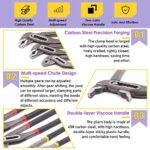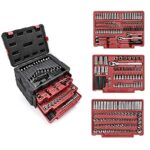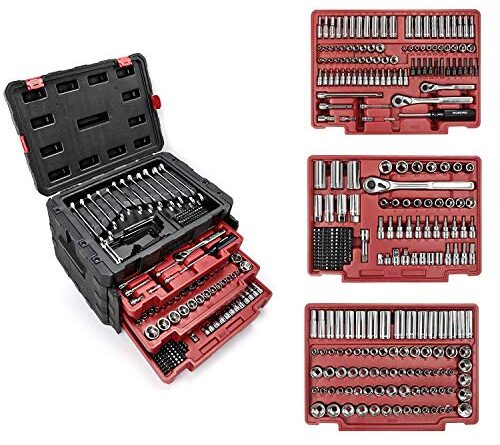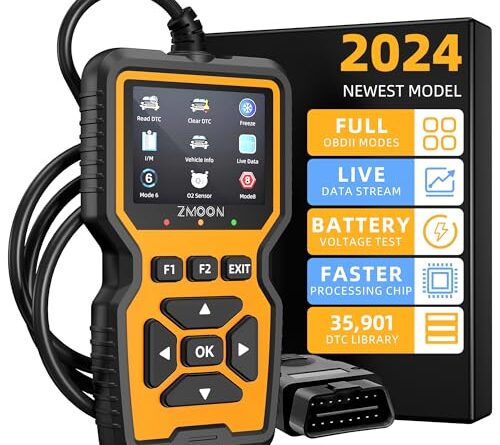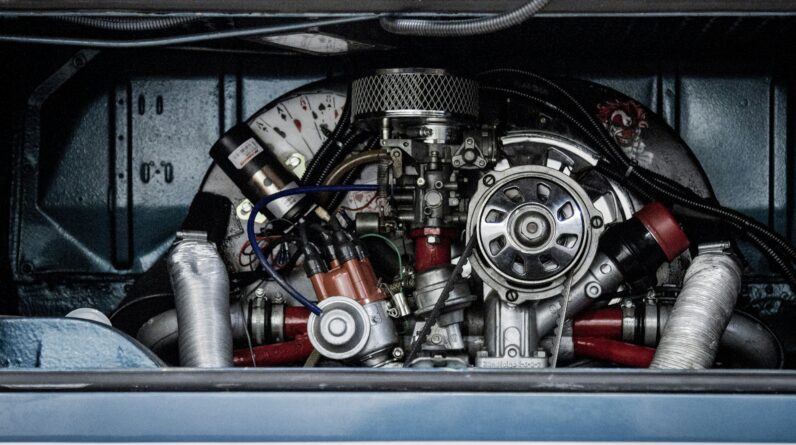
Disclaimer: This post may contain affiliate links. As an Amazon Associate, we earn from qualifying purchases.
So you’ve got a stubborn bolt that just won’t budge, and you’ve decided that it’s time to break out the trusty socket wrench. But as you reach into your toolbox, you suddenly find yourself faced with a daunting question: how do I know what size socket I need? Don’t worry, we’ve all been there. In this post, we’ll explore some simple yet effective methods to help you determine the perfect socket size for your task at hand. Before you know it, you’ll be smoothly tackling any bolt with confidence and ease.
What is a socket?
Definition of socket
A socket is a tool used to tighten or loosen nuts, bolts, or screws. It consists of a cylindrical metal shape with six or twelve sides, called points or faces, and a square drive at one end. The square drive allows the socket to be attached to a ratchet, wrench, or power tool, providing the necessary torque to fasten or unfasten various types of fasteners. Sockets are an essential part of any toolkit, whether for DIY enthusiasts or professional mechanics.
Types of sockets
There are different types of sockets available, each designed for specific purposes and applications. Some common types include:
- Standard sockets: These are the most commonly used sockets and have a regular depth, usually around 1 inch. They are ideal for general-purpose use.
- Deep sockets: These sockets have a longer depth, allowing them to reach fasteners in tight and recessed areas. They are commonly used when working with long bolts or studs.
- Spark plug sockets: Designed specifically for removing and installing spark plugs in vehicles, these sockets have a rubber insert to securely grip the spark plug and prevent damage.
- Impact sockets: Built to withstand the high torque produced by impact tools, impact sockets are made from hardened steel and are less likely to shatter or break under heavy use.
- Hex sockets: These sockets have a hexagonal shape and are used with hexagonal bolts or set screws. They are commonly used in machinery and equipment assembly.
- Torx sockets: Torx sockets have a star-shaped design and are used with torx screws, which are commonly found in electronics, automotive, and computer industries.
Understanding the different types of sockets will help you choose the right one for your specific task or project.
Understanding socket measurements
Metric socket sizes
Metric socket sizes are commonly used in countries that follow the metric system, such as most of Europe and Asia. They are measured in millimeters (mm) and come in a wide range of sizes. Common metric socket sizes include 8mm, 10mm, 13mm, 17mm, and 19mm. The size refers to the distance between two opposite points or faces of the socket.
Imperial socket sizes
Imperial socket sizes are used in countries that follow the imperial system, including the United States. They are measured in inches (in) and are less common in metric-based countries. Common imperial socket sizes include 1/4 inch, 3/8 inch, 1/2 inch, 5/8 inch, and 3/4 inch. Similarly to metric sizes, the size refers to the distance between two opposite points or faces of the socket.
Socket size conversions
Converting between metric and imperial socket sizes can be useful, especially when working on projects that involve both systems. Here are some common socket size conversions:
- 10mm is approximately equal to 3/8 inch
- 13mm is approximately equal to 1/2 inch
- 17mm is approximately equal to 11/16 inch
- 19mm is approximately equal to 3/4 inch
Remember that these conversions are approximate, and it is always best to use the socket size that matches the specific fastener requirements.
Socket size markings
Socket sizes are usually marked on the flat side of the square drive or on the body of the socket itself. Metric sizes are typically marked with the letter “M” followed by the size in millimeters (e.g., M10 for a 10mm socket). Imperial sizes may be marked with fractions, such as 1/4, or with a decimal representation, such as 0.25 for 1/4 inch.
Determining socket size
Method 1: Reference the fastener
One way to determine the socket size needed is to refer to the size of the fastener you are working with. Nuts, bolts, and screws often have their size marked on the head or side. By matching the size of the fastener with the corresponding socket size, you can ensure a proper fit.
Method 2: Measure directly
If the fastener is not marked, or if you are unsure of its size, you can measure it directly using a caliper or a ruler. For metric fasteners, measure the distance between opposite flat sides in millimeters. For imperial fasteners, measure the distance in inches between opposite flat sides.
Method 3: Use a socket size chart
Socket size charts are readily available online, in tool catalogs, or in the owner’s manual of socket sets. These charts provide a comprehensive list of socket sizes corresponding to different fastener sizes. Simply find the size of your fastener in the chart, and it will indicate the corresponding socket size.
Method 4: Ask a professional
If you are uncertain about the socket size needed for your specific task, it is always a good idea to consult a professional, such as a mechanic or hardware store employee. They have the expertise and experience to guide you in selecting the appropriate socket size for your needs.
Factors to consider when selecting socket size
Bolt or nut size
The primary factor to consider when selecting a socket size is the size of the bolt or nut you are working with. The socket size should match the dimensions of the fastener to ensure a proper fit and prevent damage.
Fastener material
The material of the fastener can also influence the socket size selection. Soft materials like aluminum or brass may require a socket with a tighter fit to prevent stripping. Hardened steel fasteners may require a socket with more gripping power to avoid slipping.
Application and torque requirements
The specific application and torque requirements of the task at hand should also be taken into account. Some projects may require higher torque, and therefore a larger socket size, while others may need a smaller socket for precision work in tight spaces.
Common socket sizes
Metric socket size range
Metric socket sizes commonly range from 6mm to 24mm, although larger sizes may be available for specialized applications. Some common metric socket sizes include 8mm, 10mm, 13mm, 17mm, and 19mm.
Imperial socket size range
Imperial socket sizes typically range from 1/4 inch to 1 inch, with 3/8 inch, 1/2 inch, and 3/4 inch being common sizes. Larger imperial socket sizes, such as 1 1/4 inch or 1 1/2 inch, are often used in heavy-duty applications.
Socket sets
Socket sets are convenient collections of sockets in various sizes, often accompanied by a ratchet or wrench. They come in both metric and imperial sizes, providing versatility for a wide range of tasks. Socket sets are a practical investment for both DIY enthusiasts and professionals, as they provide a comprehensive selection of socket sizes in a single package.
Using the wrong socket size
Consequences of using the wrong socket
Using the wrong socket size can lead to several issues. Firstly, it may not fit properly onto the fastener, resulting in the socket slipping or not gripping tightly. This can lead to stripped fasteners, rounded corners, or damaged sockets. Additionally, using the wrong socket size may result in inadequate torque, leading to insufficient tightening or loosening of the fastener.
Damage to fasteners or sockets
When a socket size does not match the fastener, it can easily cause damage to both the fastener and the socket. If a socket size is too large, it can round off the corners of the fastener, making it difficult to remove or tighten properly. Conversely, using a socket that is too small can cause the fastener to become stripped or damaged. It is essential to use the correct socket size to prevent such harm.
Safety risks
Using the wrong socket size can also pose safety risks. A loose-fitting socket can cause the tool to slip off the fastener, potentially leading to injuries or accidents. Moreover, if a socket is not properly tightened, the fastener may not be secure, compromising the structural integrity of the assembled parts. Always prioritize safety by using the correct socket size for your tasks.
Socket size equivalents
Metric to imperial socket size conversion
Converting between metric and imperial socket sizes can be helpful, especially when working on projects that involve different measurement systems. Here is a general guide for metric to imperial socket size conversion:
- 6mm is approximately equal to 1/4 inch
- 8mm is approximately equal to 5/16 inch
- 10mm is approximately equal to 3/8 inch
- 13mm is approximately equal to 1/2 inch
- 17mm is approximately equal to 11/16 inch
- 19mm is approximately equal to 3/4 inch
- 24mm is approximately equal to 15/16 inch
Imperial to metric socket size conversion
Similarly, here is a general guide for imperial to metric socket size conversion:
- 1/4 inch is approximately equal to 6mm
- 5/16 inch is approximately equal to 8mm
- 3/8 inch is approximately equal to 10mm
- 1/2 inch is approximately equal to 13mm
- 11/16 inch is approximately equal to 17mm
- 3/4 inch is approximately equal to 19mm
- 15/16 inch is approximately equal to 24mm
Remember that these conversions are approximate and can vary slightly depending on the manufacturer or specific measurements.
Tips for socket size selection
Start with commonly used socket sizes
If you are unsure which socket sizes to invest in, start with the most commonly used sizes. For general household tasks, having sockets in the range of 8mm to 19mm for metric sizes and 1/4 inch to 3/4 inch for imperial sizes should cover a wide spectrum of projects.
Consider a socket set with various sizes
Investing in a socket set is a practical choice as it provides a comprehensive range of socket sizes in one package. Socket sets usually come with a storage case and include a variety of metric and imperial sizes, making them versatile for different projects.
Refer to the manufacturer’s guidelines
When using a specific brand or type of fastener, it is always a good idea to refer to the manufacturer’s guidelines. They may include specific recommendations or requirements for socket sizes, ensuring the best fit and performance.
Seek professional advice if uncertain
If you are unsure about the socket size required for a particular task or project, it is always best to seek the advice of a professional, such as a mechanic or hardware store employee. They will have the experience and knowledge to guide you in selecting the appropriate socket size for your needs.
Additional tools for socket size determination
Socket size gauges
Socket size gauges are handy tools designed specifically for determining socket sizes. They consist of a set of metal pieces, each with a specific size stamped on them, ranging from small to large. By finding the metal piece that fits snugly over the fastener, you can identify the correct socket size needed.
Bolt and nut sizing templates
Bolt and nut sizing templates are plastic or metal templates that contain various shapes and sizes of nuts and bolts. By matching your fastener with the corresponding hole on the template, you can determine the correct socket size required.
These additional tools are especially useful for those who frequently work with fasteners and require a quick and reliable method for socket size determination.
Conclusion
Knowing the appropriate socket size for your specific task is crucial to ensure safe and efficient fastening or unfastening of nuts, bolts, and screws. By understanding the different types of sockets, socket measurements, methods for determining size, and the factors to consider during selection, you can confidently choose and use the right socket size.
Referencing fastener size, measuring directly, consulting socket size charts, or seeking professional advice are all viable methods to determine socket sizes accurately.
Remember to consider factors such as bolt or nut size, fastener material, and torque requirements when selecting a socket. Using the wrong socket size can lead to damage, safety risks, and compromised results, so always prioritize using the correct size. Explore socket size equivalents, such as metric to imperial conversions or vice versa, to work seamlessly across different measurement systems if needed.
Additional tools like socket size gauges or bolt and nut sizing templates can further assist in determining socket sizes accurately. Whether you are a DIY enthusiast or a professional, having a variety of socket sizes in your toolkit, such as those found in socket sets, is advantageous for a wide range of projects. Remember, when in doubt, seek advice from professionals to ensure you have the right socket size for the job at hand.







